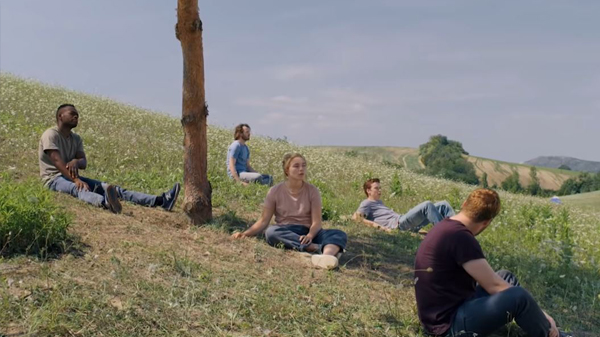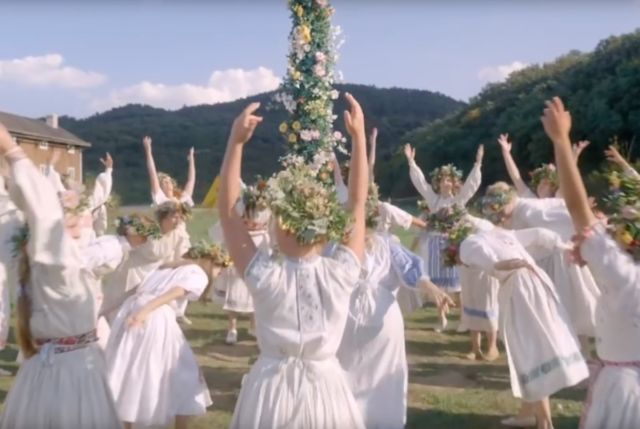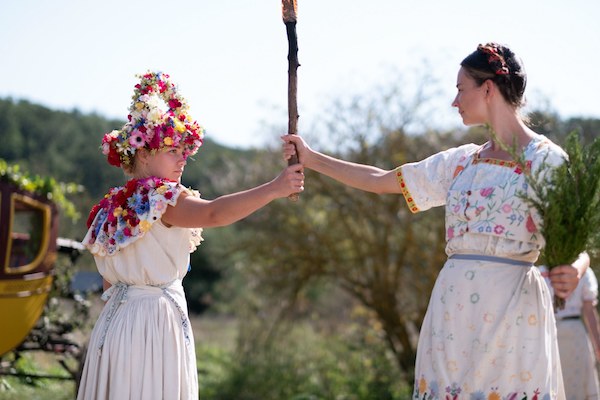Ari Aster has described his latest film as more of a breakup movie than a horror movie. Pinpointing the exact moment of the fallout and one woman’s subsequent self-actualisation, Savina Petkova finds how Midsommar in fact finds catharsis in its reclamation of the female orgasm.
“You need to find a chick that actually likes sex”, is a dubiously insightful bro-tip that can easily pass for customary male banter. In fact, it can slide off the conversational radar so effortlessly that it leaves no narrative trace in Ari Aster’s Midsommar. However, this line provides a crucial assumption (the girl does not like sex) and raises imminent questions (why is that even up for discussion?). In answering the latter, we can then revisit and reassess Aster’s folklore horror break-up film from the perspective of its female protagonist. Even before Dani (Florence Pugh) and Christian (Jack Reynor) arrive at Hälsingland’s to partake in its midsommar festivities, the couple is introduced by its hardships and lack of intimacy. The midnight sun’s blinding shine provides a chilling canvas for the spectacle of a disintegrating relationship, taking turns with the film’s gory visuals. Despite its blood-soaked narrative, Midsommar works on a more ephemeral level which can be traced in its metamorphoses from breath to scream.
What if the hero in Midsommar was not a person, but breath itself? Within this film’s world, breathing plays an integral part in all the rituals, as characters inhale and respire with sharp, guttural noises. Breath’s tragic alter ego is the scream. Dani’s shrieks parallel the narrative itself: first a verbalisation of trauma following the loss of her family (a deafening scream that aurally frames a whole sequence), then as internalisation of grief (her muffled whimpers and suppressed tears), to a response of separation. In this last moment, Dani is joined by the women of the Swedish commune, and their synchronised cries elevate her individual pain to universal, shared mourning. In Ancient Greek tradition, women played the cerebral part in funeral rites, with collective chants of dirges, staging emotional turmoil as external, thus visible and communicative. The noticeable absence of screams denoting pleasure here pinpoints the troubling lack of intimacy throughout the film. As Dani and Christian are framed as an enduring, but codependent couple (for the past four years and two weeks, to be precise), we might safely infer that their relationship should provide comfort, affection, and pleasure. Yet in the film they never share a bed, nor a single caress or kiss, their only gesture of intimacy is an occasional hand over the shoulder or a short-lived hug.
While neither Dani nor Christian express sexual frustration, the role of a spokesperson for bedroom activities is assumed by Mark (Will Poulter), a particularly obnoxious lad with an infantile fixation on sexual activity. He is the proud announcer of the fact that Dani, allegedly, does not “like sex”, an utterance placed in the casual conversations that all seem to center around an all-encompassing sense of entitlement, which leaves the lads ignorant of individual women and personal relationships. Redressing their own frustration as friendly advice, the guys all advocate for Christian to break up with Dani and focus on his thesis, on the pretext that his girlfriend is “abusing him” by calling him frequently throughout the night.
Comically, the backdrop of this otherwise banal talk is titillated by an infamous photo coupling Sophia Loren and Jayne Mansfield’s low-cut dress. Mansfield is leaning in, exposing her breasts over the creases of her shiny satin dress. In an interview with Vanity Fair, Loren confessed that even she was frightened by the bombshells’ revealing attire: “..that everything in her dress is going to blow - BOOM! - and spill all over the table.” Placing this photograph as a set prop in the tempting environment of a food joint seeks to emphasise the concept of sexual appetite. However, the dialogue manages to render that lurking desire impotent and nullify its titillating qualities. Christian is the only passive and sexually apathetic one at the table, while Mark suggests that he “could be getting this girl [the waitress] pregnant”. The gesture of tipping the waitress is done with a generous dismissal, and the monetary transaction reflects only her half-minute-long presence. Christian’s relation to women is to be said, reductive. The shared banter between the guys cannot revitalise the potency of Loren and Mansfield’s photograph, nor rehabilitate the waitress to the status of a desired woman.
As the boys’ gang travels to Sweden, accompanied by Dani, it seems more like an act of pity than actual empathy to let her tag along, despite the fact that she lost her entire family to a tragic turn of events. The actual division between her and everyone else is amplified with episodes of dreams or hallucinatory trips – Dani’s overpowering alienation prevents her from verbalising both the traumatic aftermath of the incident and her need for intimacy. In preparation for the narrative climax, the film’s plot unfolds slowly with rapid punctures, the most symbolically potent (and least bloody) one being the May Queen dance.
Central to the Hårga celebrations is a dance competition to crown a new May Queen. This ritual gathers every girl of age to participate in a collective dance around the specially built MayPole (its shape a perfectly uncanny mixture of phallic and circular elements, all adorned in flowers). Dressed in similar embroidered white robes, the braided-haired women wear flower crowns and together take a sip from a “special tea” for stamina. Our anticipation follows the lead of Dani’s hesitant but curious steps.
The sequence begins with a birds-eye view of a spiral of bodies, the women hand in hand, arrested in their motion. The circular allusion to infinity here represents the horizontal stability, the levelling of dancers with nature, and Dani’s hallucination of her feet becoming one with the grass appears as an earthly blessing. The assembly of women is linked to, as announced, an ancient Nordic tradition of “life-holding defiance” against Death (reminiscing the famous Medieval iconography of “Totentanz” or “Dance of Death”), as the ritual leader recalls a frenzy that caused all maidens to dance until they dropped dead. However, reversing the ritual from death- to life-affirming already suggests a special preference for Dani, as she is the only outsider allowed to participate. The bright natural light and the switch from static to handheld camera movements mimic Dani’s dizziness, as her shallow breathing mutes all other diegetic sound. A heart thumping and deepening breath form the rhythm of this dance of life.
Circular dance formations and rounded flower crowns compose an ode to the Midnight sun (also disk-like), while invoking psychoanalytical associations with the womb. In such a cosmic alignment of symbols, Dani’s cheerful disposition and surprisingly adept dancing are also inscribed in the universal harmony. Even though the plot of Midsommar strives for a dissolve: an entropy that finds itself disintegrating from cosmos to chaos, this sequence plays out like a special arrangement of planets and their orbits. Juicy, sensuous cinematography brushes against soft-focus bodies and builds up gradual tension by juxtaposing aerial shots, long shots, and facial close-ups, while keeping Dani central to the picture at all times. The whole film plays out on Florence Pugh’s expressions. Her deeply visceral character-acting blends together utter confusion and despair with just the right amount of curiosity, to ascend a smile on Dani’s mostly creased and troubled look. The film’s cinematic grammar works in her close-ups more than anyone else’s, while still allowing the spectatorial gaze to identify with hers: as omnipresent, Dani’s eyes seem the entrance point for the narratively crucial sequences.
As the dance picks up its pace and the bodies accelerate, they brush each other, hands clap, hold and then let go, and tiresome feet collapse on the ground. A competition of stamina divides this collective experience into individual efforts, as the circle breaks off and individual women’s bodies get more attuned to the intensifying beat of the drum. Rapid cuts break down the freedom of events unfolding, as a more fragmented image of Dani comes into focus. Or rather, loses its focus. In its often trippy gaze, the camera trades its sharp deep focus to a much softer one to make even the grass radiate. White robes glow as flowers and blazing coloured details blend into a whole painter’s palette. This swirl of light and colour is intoxicating and affective, allowing the close ups and long shots to push us in and pull us out of the frame in the rhythm of the dance.
In this whirlpool of feeling and seeing, Dani is framed smiling, her head tilting pleasurably from side to side, as her breathing overpowers all other diegetic sounds. A wave of breath washes over the image and here it ruptures: it explodes, it multiplies, it reflects itself. Such an expressive use of double exposure emanating from Dani’s beatific face offers the visual experience of ecstasy. The Ancient Greek root of the word ἔκστασις or ekstasis gives it away quite literally: ec/ex (out) + stasis (state), or “out of state”, “out of oneself”, and by superimposition of Dani’s sensual peak, Midsommar’s visual language has presented a metamorphosis. Its main character is sincerely smiling, for the first time as we see, bewitched by her own company, and gloriously in tune with herself. Dani achieves self-reliance by becoming the May Queen, and her ecstasy releases the suffocating tension to the point when she can breathe again. The gasp for air as she smiles parallels an orgasmic experience, a dispersal of self in fragments of pleasure, to then assemble anew. She isn’t the chick that doesn’t enjoy sex anymore.
Dani’s afterglow is celebrated by the whole community as they match her new status as royalty with physical elevation: she is brought up into the air on a physical pedestal, a carriage takes her off to her newly attained sacred duties; she sits at the head of the festive dinner table. She attains all insignia (including a bigger crown of actually breathing flowers) of power, which is traditionally inscribed into a patriarchal male model. Dani’s attainment of power coincides with self-assertion and post-orgasmic metamorphosis. “Can Christian come with me?”, she pleads at the sight of her (ex)lover’s quivering face, revealing that the Queen is, after all, merciful. Alas, the answer is abrupt: “Nej. The Queen must ride alone.”
In a way, Dani’s hierarchical climb symbolises her journey (inward) from insecurity to regaining power over her body. Her ascent also produces a certain degree of alienation (outward) from both Christian, and their union that was dangling by a thread before. For the queen, “alone” becomes a synonym of “self-sufficient” and “independent”, evoking the post-orgasmic separation when one returns to her own body. In the climactic moments of ecstasy, pleasure dismembers the body and orgasm is not felt in only a single part of the body: it erupts and extends beyond its physical boundaries. Orgasm offers a form of transcendence, a fluid state, followed by a reiteration of one’s corporeality: I am my body (again). The film crowns Dani for this achievement, and provides her with an allegorical blessing so she can break up with her traumatic past, signified by Christian. After the dance competition, the power vested in her by the Hårga comes to represent her self-reliance, which in turn, functions as the final judgement, bringing Midsommar to a spine-chilling ending.
Man consumed by the mystical nature of/and woman: this underlying premise resonates with the fear and intimidation of female sexuality. In its pagan worship of virginity, pubic hair pies, fetishism, and fixation on blood lines, the world of Midsommar fleshes out a tale of conflicted power between male and female, a transaction based on trauma and impotence. In the film’s reception, a certain gendered trail of response populated social media and was then elevated to a memeified inside joke: “Couples fight over Midsommar”, the biggest gender divide since Ross and Rachel were (were they?) on a break. Boyfriends camp for Christian, calling the film’s ending “unjust”, “uncalled for”, and “too much”, while their girlfriends quote Dani verbatim: “I could see you doing something like that”. What does this strange mise-en-abyme suggest?
If we return to the film’s beginning, we find Dani pondering over whether she brings too much “baggage” into the relationship, if she’s too overwhelming, or too much. Being “too much” is a fear that has been incised into womens’ deepest insecurities since teenhood. Here, this insecurity manifests itself through a folk-horror tale, a generous genre film that literises abstract fears while employing allegorical storytelling to showcase sexual liberation. In this world devoid of intimacy, Dani’s reconciliation with herself is possible through firstly, experiencing universality in the ritual, then individuation in the newly attained status of hierarchy. Midsommar, then, starts off as a film about lack: the lack of love, or will to connect, but its insular experience ultimately serves a purpose that is cathartic, or even better, orgasmic.
Savina Petkova (@savinapetkova) is a film critic/PhD candidate based in London who lives from one film festival to another. She specialises in animal representations in contemporary film and writes for Electric Ghost Magazine and MUBI Notebook.
READ ME is a platform for female-led writing on film commissioned by Girls on Tops. Louisa Maycock (@louisamaycock) is Commissioning Editor and Ella Kemp (@ella_kemp) is Contributing Editor.







